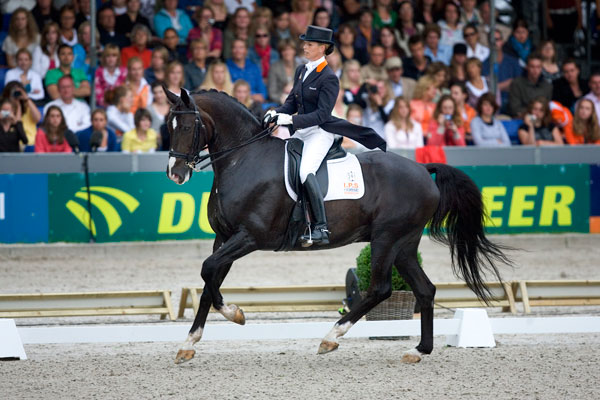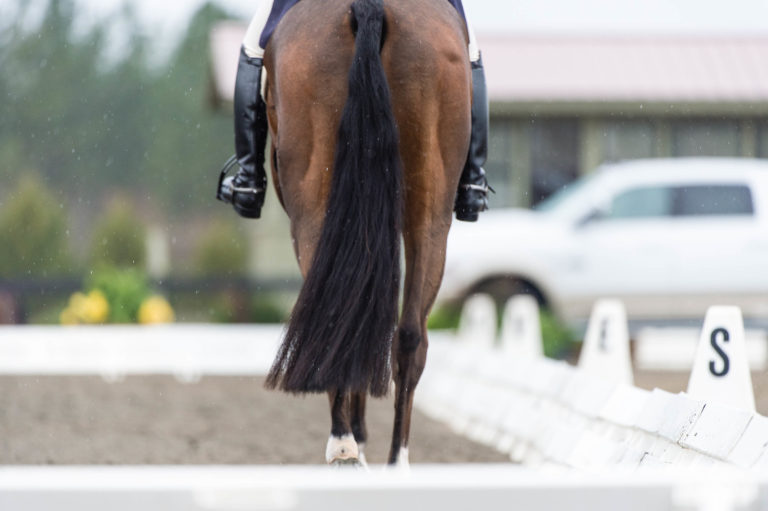The pursuit of becoming a dressage rider is a lifelong journey filled with many light-bulb moments along the way. Each of these revelations allows us to peel off another layer of the onion, bringing us to another level of understanding in this very detailed sport we all love (most of the time).

For me, one of these moments was beginning to understand the concept of straightness in the outside rein; what it means and the impact it has on the horse and the rider’s ability to truly and correctly begin to supple the horse with the lateral bend in the body. Most horses are stiffer tracking left than tracking right and have the stronger hind leg on the left side. As a result, they are often stronger in their jaw on the left side and avoid contact on the right side of the bit. One often sees riders overbending the horse in the neck to the left in an effort to create softness and a feeling of left bending. These horses have a harder time stretching their ribcage on the right side when tracking left and tend to fall on their left shoulders with a strong left hind leg, which tends to fall in toward the inside of the circles and corners.
When tracking right, these same horses are considered to be hollow to the right. They are softer in the neck, jaw and poll and tend to avoid contact on the right rein. This is because the right hind is weaker and tends, in many cases, to cross to the left avoiding pushing forward into the contact on the right side of the bit causing the horse to escape with his quarters to the outside. In this example, which I have observed over and over again in my judging and teaching, the horse who is stiffer to the left carries his hindquarters to the left of his shoulders in both directions. The rider has the false illusion that the horse is bending to the right because his neck is curved too much to the right. In other cases the weak hind leg (in this example, the right hind) avoids carrying the weight by escaping to the inside which pushes the horse more onto his left shoulder, creating the stronger contact on the left side of the bit.
The first horse I was able to develop to the Grand Prix level was a 15.3-hand Dutch Warmblood gelding named Milestone. He fit into the category just described perfectly, and his lateral stiffness was perhaps exaggerated by being somewhat short-coupled. I fell into the trap of keeping him overpositioned to the left in the neck in an effort to keep him softer in the left rein. My long-time trainer, Roel Theunissen, was constantly on my case about why I had him bent left too much. My answer was always that I was trying to keep him from grabbing the left side of the bit.
The beginning of my breakthrough in that department came when I decided to ride outside one day with no one watching. I was determined that no matter what Miles’ head and neck were doing, or what I perceived they were doing (not always one and the same, particularly back then), I was not going to bend him with my left hand or give my right hand forward for one second. Well, I can tell you that I was convinced he was counter-flexed in all the work we did that day tracking left. Everything looked backward from the withers forward to me. However, Miles was finally rounder over the back and not pulling on my left arm.
The next lesson I had with Roel, I remember him asking me what I had done differently. I told him that I had gone home and looked under the bed for my damn right rein and had finally found it! I wish I could say it was all smooth sailing from that moment forward, but it was only a beginning, which led me toward the understanding of what it means to have a horse “round in two reins” and “straight in the outside rein.” The horse must become round over his topline, longitudinally supple to a certain extent, before he can bend around the rider’s inside leg without the shoulders escaping to the outside with the head and neck positioned too much to the inside. Horses are much more flexible in front of the withers than behind, and we humans are quite visually oriented, so we tend to think that what we see in front of the saddle is representative of what’s happening under our seat and leg. Mirrors are invaluable to the dressage rider for this reason alone.
The next challenge in understanding the importance of equal contact in the two reins is developing contact on the inside rein and being softer in the outside rein—another not-so-easily understood concept. After all, haven’t we all had it drummed into us that we ride from the inside leg to the outside rein? Well, without necessarily riding the horse in counter-flexion (a useful tool in and of itself), we can ride with what I think of as “inside-out bending aids.” In other words, I might find that my outside leg is helping me to ride the horse toward the contact on the inside rein and my outside rein is allowing the horse to stretch toward that inside rein rather than being restricted from truly bending around the rider’s right leg, in this example.
Understanding this concept of straightness and correct bending is extremely important in this example because the horse I have described as being hollow to the right will be deceptive to ride in shoulder-in because of his tendency to carry his haunches to the outside. The rider will be easily fooled into riding a shoulder-in to the right with too much angle, allowing the haunches to escape to the outside and avoid collection. The rider who truly understands the importance of using the outside leg to create bend in the horse’s body around the inside leg is well on the way to understanding collection and self-carriage.
All of this requires a rider who has truly developed an independent seat, leg and hand and who is aware and in control of where her six major body parts are. I think of those six parts as being two legs, two hands/arms and two seat bones.
This independence allows us to find the true center of the horse, despite his innate crookedness, and line up his body parts to facilitate the equal use and strengthening of both hind legs and channel the energy/impulsion from behind into equal contact on both reins. I don’t think it is possible to truly appreciate this until one has trained and ridden one-tempi changes, piaffe and passage, exercises that can be perfected and correct only when the horse has achieved straightness.
Sandy Osborn is a USEF “S” judge and a USDF gold and silver medalist. Former Director of Equitation at the University of Massachusetts, she has studied extensively with Roel Theunissen and is based at Ashland Farm in Covington, Georgia.











